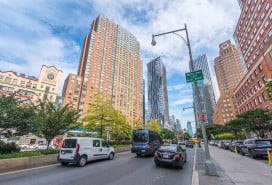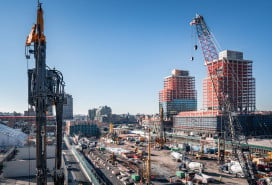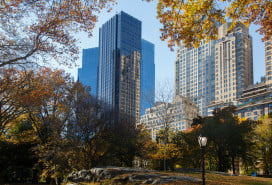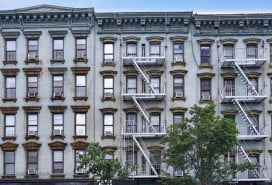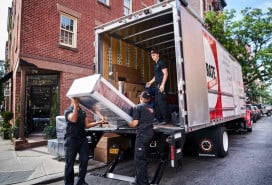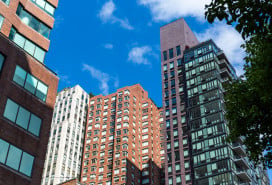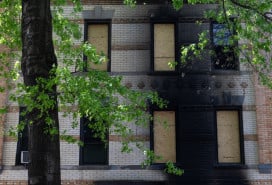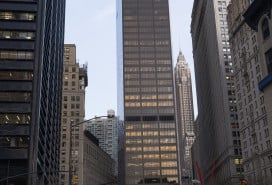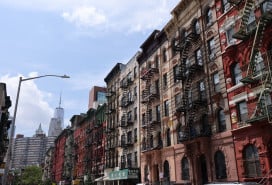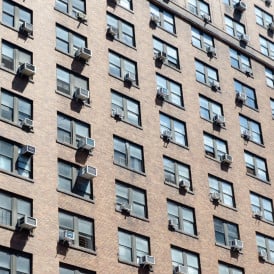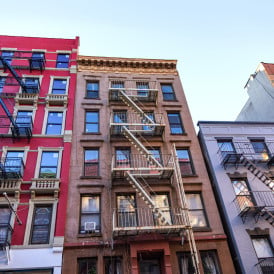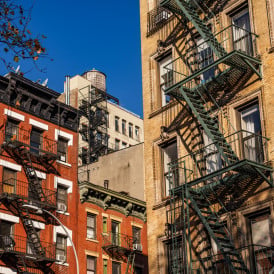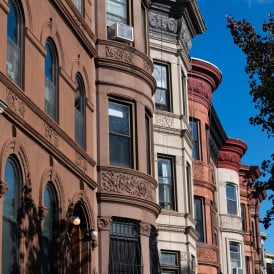Can I install a washer/dryer combo in my NYC co-op?
- You'll need to follow your building's wet-over-dry rules and get the necessary permits
- Keep in mind buildings with old plumbing can't handle a washer/dryer in every unit
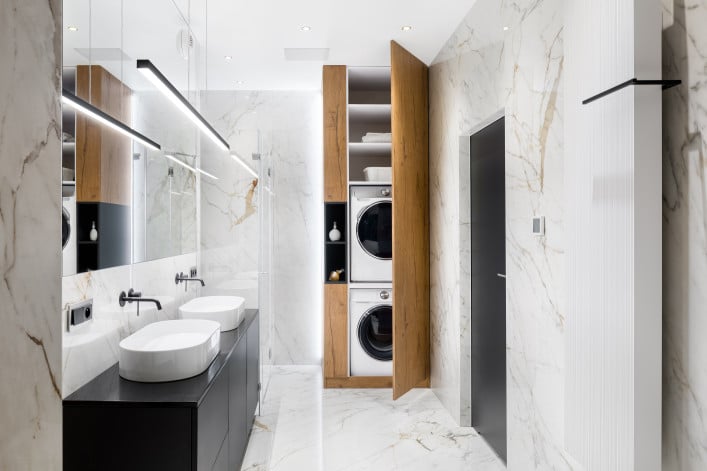
One option is to replace a tub or shower stall with a stacked washer and dryer in a second, full bath. Or convert a half-bath into a laundry station.
iStock
I want to install a washer/dryer combo in my co-op apartment. What do I need to know about the approval process, what kind of laundry machines should I get, and how much will they cost?
A washer/dryer of your very own is on most owners’ wish lists. Carrying loads of laundry up and down from your building’s basement—or back and forth to the local laundromat—can get old quickly. However, if you’re thinking of forking over cash for a washer/dryer combo and installing it in your apartment, there are a few considerations to keep in mind.
Before allocating closet space to house your new appliances, you’ll need to obtain permission from your board or building management. That’s because some older plumbing systems aren’t equipped to handle the workload of washing machines in every apartment. In addition, there are “wet-over-dry” rules to be aware of, as well as permitting and safety issues.
Assuming you can get approval—itself a tall order—you’ll need to choose the right location and appliances for your situation and stay on the right side of New York City’s building codes.
The following expert guidance will help you figure out your options.
[Editor's note: An earlier version of this post was published in November 2023. We are presenting it with updated information for November 2024.]
Check with your board or building
Many NYC buildings, whether rentals, co-ops, or condos, do not allow in-unit washer/dryers—period. Some co-ops and condos will only allow them on a case-by-case basis, while others have blanket policies. You should always get your board or building management to approve the addition; otherwise, the consequences can range from having the machines removed to owing thousands of dollars to your neighbors if there’s a fire or flood linked to the installation.
There’s generally a logical reason why these appliances aren’t permitted. In older buildings, the waste pipes can be either too small or packed with sediment, or the building or specific apartment line may have existing drainage issues. So adding suds can cause backups that affect nearby apartments.
What’s more, if your washing machine malfunctions or overflows, it could cause damage to the floors below. This is why many buildings require a containment pan under the washing machine, along with an overflow sensor in the pan and an automatic shut-off valve.
According to architect Jorge Fontan, founder of Fontan Architecture, some buildings may require you to add a waterproof membrane underneath the finished floor that extends at least six inches up the walls. He also recommends including soundproofing underlayments if you are installing new floors; if not, you can install the machines on sound-isolating pads to help absorb vibrations.
Dryers can present their own hazards, as discussed below. Should you get the coveted go-ahead, you’ll still need to be mindful of Department of Building compliance (discussed below).
Beware of wet-over-dry restrictions
With approval in hand, the next step is to figure out where the units can be installed. Most likely, they will need to be in or near a “wet space,” generally a kitchen or bathroom, to be close to the waste and supply pipes (aka the “stack”).
An adjacent closet is a common option, though you may not want to give up that precious storage space.
If you do have a closet in mind, make sure an installation there doesn’t flout wet-over-dry rules where any potential leaks would cause damage to any "dry" spaces like a bedroom or living room in the apartment below you. If all the units in your line share the same layout, this will be easy to predict, but not if you or your downstairs neighbors have made alterations. The board or property manager can advise you on this.
Be sure to comply with the DOB
When installing a new washing machine, the city’s Department of Buildings requires a master plumber to obtain a permit and do the work. Depending on the scope—for example, if you’re altering a closet or the electrical or plumbing lines—you may need to get additional permits.
Gas machines have a whole other set of issues: You’ll need to tap into an existing legal gas line and provide adequate ventilation, which is why these models are typically put in a windowed bathroom or kitchen.
The DOB does allow gas appliances to be installed in closets as long as the code requirements for ventilation are met (for example, by connecting to the building's mechanical system). The closet must also have a sprinkler head in buildings where a full sprinkler system is required. BTW, it's the same for an electric dryer.
You’ll need a final DOB inspection for all gas and electric work to make sure it’s been done properly.
| Key considerations when adding a washer/dryer to a NYC apartment | |
|---|---|
| Board or building approval |
|
| Where to put them |
|
| How much you'll spend |
|
Stacked vs. side-by-side units—and where to put them
Often, the most logical place for these appliances is in a second, full bath—such as by replacing a tub with a shower stall and a stacked washer/dryer. Another option is to convert an entire half-bath into a laundry station.
Some owners install washer/dryers in the kitchen, close to plumbing and gas lines. On the downside, space will be a little tighter, and the height of many units is taller than a typical counter height.
Jennifer Morris, interior designer and founder of JMorris Design, says clients are increasingly looking to create space in their apartments where they can hang clothes to dry.
“Air drying clothes is so much better on the wear of clothes than a dryer. If you can make room for clothes to hang, then you can do a quick tumble to get them soft," she says.
An all-in-one washer/dryer is another space-saving option, though according to consumer reviews (and our own in-house experience), the dryer can take as much as three times longer than a regular dryer, meaning you’ll need to do smaller loads at a time—and forget about washing large items like comforters.
A lot of combo units are ventless, meaning you can install them anywhere there’s plumbing (such as in place of a dishwasher). Some of them, however, do require vents. Either way, you’ll need to address lint build-up (more on this below). You may also need to give ventless appliances regular wipe-downs—and once every few years, you might have to take the unit apart and scrape the inner workings clean.
Going with gas or electric dryers
Appliances with Energy Star ratings are going to be the most efficient. According to the energy star guidance, gas dryers may cost less to operate but typically have a slightly higher initial price tag. Like most electric dryers, gas models need venting to the outside but they also require a dedicated gas line, which may not always be practical and could add to the cost of installation.
Electric dryers may be slightly cheaper to purchase initially, but can be more expensive to run.
If outside venting (or having a dedicated gas line) isn’t practical, you can buy ventless electric models. Most standard-size electric models need a 240-volt outlet, which is not always easy to facilitate in older buildings. Some of the more compact dryers on the market, however, need only a 120-volt wall outlet.
The pros and cons of high-efficiency machines
High-efficiency appliances generally use less water and call for specific detergents that produce fewer suds, making them easier on plumbing and the planet (look for “He” on the label). Indeed, they are the only models allowed by certain buildings.
Beware of a couple of potential downsides: Some owners complain of mildew problems after prolonged use. It's best to keep the washer door cracked open between uses to dry out the interior. The wash cycle is also longer than normal, trying the patience of many users, though the drying time will be shorter (thanks to the extra water extraction capabilities of these washers).
Why the lint filter needs to be cleaned—diligently
Lint build-up can be very dangerous—you’re combining heat and a flammable substance in close proximity. So you need to clean the lint filter with every use. This will typically be spelled out in the appliance's owner manual.
You may also want to have a professional inspect the exhaust areas and remove lint buildup every year or two. A dryer inspection typically runs less than $100; cleaning could cost you another $200. It's a small investment that can avoid a much larger cost in the future, and an important step in protecting yourself and your neighbors.
If your appliance vents to the outside, be especially cautious about longer ducts with "elbows," which can increase the lint build-up. It’s possible the lint can harden or even get wet due to condensation. One solution is to add a booster fan at the midpoint or an exhaust fan at the end. You can also have a thin section of the duct cut out and a second, removable lint trap added to catch build-up. Hire a professional to advise you on what's warranted.
And consider buying a machine that's equipped to shut down in the event of a fire—many newer models have this safety feature.
How much you’ll spend
The cost of adding a stackable washer/dryer to a closet space could stretch to around $6,500. That includes the cost of running new plumbing and electrical lines to the space. However, there may be circumstances where you can cut some of that cost if you’re able to take advantage of existing lines, such as in a bathroom or kitchen.
Be prepared to spend around $1,500 to $2,000 or so for a stackable, apartment-size washer/dryer combo from manufacturers like GE or Frigidaire. (The recommended combo by at least one source is this GE model, listed at $2,899.)
Maytag is a bit cheaper, with matched stackable units ranging from $728 to over $1,000.
Electrolux washers and dryers start at around $1,000 each; stacked combos range from $2,099 to $2,799.
Miele machines run between $1,500 to over $4,000; Bosch's compact washers and tumble dryers cost $1,149 to $1,829 each.
Ventless washer/dryer all-in-on combos, such as from LG (often the top-rated option), start at around $1,600, while its WashTower stacked units range from $2,600 on up.
As with other home appliances, it’s always a good idea to purchase the highest quality models that fit your budget. Given the average lifespan for a washer/dryer is over 10 years, you’ll be spreading that investment over the long haul.
—Earlier versions of this article contained reporting and writing by Tracey Kaler and Mimi O'Connor.


